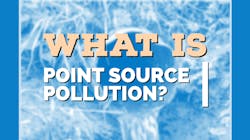Pollution can arise from any operations involving chemicals, ranging from industrial operations to farms that raise livestock. Depending on the source of origin for the chemicals, the pollution can be point source pollution or non-point source pollution.
Definition of point source pollution
U.S. EPA’s definition of a point source pollution is “any single identifiable source of pollution from which pollutants are discharged such as a pipe, ditch, ship, or factory smokestack.”
The legal definition of point source pollution is in section 502(14) of the Clean Water Act which states:
The term “point source” means any discernible, confined and discrete conveyance, including but not limited to any pipe, ditch, channel, tunnel, conduit, well, discrete fissure, container, rolling stock, concentrated animal feeding operation, or vessel or other floating craft, from which pollutants are or may be discharged. This term does not include agricultural stormwater discharges and return flow from irrigated agriculture.
Examples of point source pollution
Pollutants discharged from factories and wastewater treatment plants are two common types of point source pollutants. Factory operations include oil refineries, pulp and paper mills, and chemical as well as automobile manufacturers. These typically discharge one or more pollutants into the water usually after treatment.
Some pulp and paper mill operations send their wastes to the wastewater treatment plants for treatment. The wastewater treatment plants, after treating the wastes, release the treated effluents into the streams or rivers. In either case, the National Pollutant Discharge Elimination System comes into play and is explained later in this article.
The 3 sources of point source pollution
- Factories;
- Wastewater treatment plants, including municipal wastewater treatment plants; and
- Power plants.
The first two are mentioned in the previous section. For the third, power plants can generate harmful airborne pollutants such as fly ash. Small in size (microns), these particles, in addition to carbon, also contain heavy metals and thus they are toxic and can cause health problems as they can easily be inhaled.
EPA’s definition of point source pollution includes “smoke-stacks, discharge pipes, and drainage ditches” for conveyances from which pollutants can be discharged. Factories typically contain all three of these structures while power plants could contain some or all of these. Wastewater treatment plants contain discharge pipes and some also contain drainage ditches.
Point source pollution vs. non-point source pollution
The basic difference between point source and non-point source pollution is how the pollutant is discharged. Point source comes from a single point source whereas non-point source comes from non-discernable sources. Most pollutants that originate from land-use, for example, are non-point pollutants as they are not easily attributed to a single point of discharge and they mix with other sources. Non-point source pollution is discussed in the next section.
Definition of non-point source pollution
According to U.S. EPA, non-point source pollution is any pollution that does not meet the legal definition of point source pollution. In general, non-point source pollutants are pollutants that originate from large areas rather than from single identifiable sources. Often termed “diffuse pollution” because they spread and mix with other pollutants, their impacts occur on a wide area.
Examples of non-point source pollution
Run-offs from urban land use and from on-site wastewater treatment systems are examples of non-point source pollution. During rainfall, stormwater run-off from the streets is contaminated with surface contaminants including car oil and tire particles. This mixes with runoff from soil and sediments from construction sites and also with chemicals from industrial areas.
Similarly, run-off can also occur from agricultural land use. In farming areas, pesticides, fertilizers, and animal manure can wash along with the soil into the water bodies.
How is point source pollution regulated?
The National Primary Discharge Elimination System (NPDES) program regulates the discharge of pollutants from point sources to “navigable waters” also referred to as “waters of the US”. Facilities or operators of the facilities require NPDES permits if they discharge pollutants from specific point sources into particular types of water bodies in the United States. EPA’s website on NPDES provides basic information about the NPDES permits and also about who needs an NPDES permit.
Who must comply with point source pollution regulations?
All NPDES permit holders must comply with the regulations on discharging point source pollution. Information about the NPDES program and permit is available on EPA’s website.
Challenges with managing point source pollution
The definition
The term “point source” is very broadly defined in the Clean Water Act. While it includes “any discernible, confined and discrete conveyance such as pipes, ditch, tunnel, conduit, container”, it also includes “vessels or other floating craft” that can discharge pollutants. This is a very broad definition.
The term “point source” also legally includes concentrated animal feeding operations. These are large farms that raise livestock. The animal waste material (considered raw sewage), if not discarded, can wash into nearby water bodies and add to the levels of nutrients and microorganisms that can impair these water bodies.
The broad definition of point source in the Clean Water Act is confusing. What if the pollutant originates from multiple, single sources and mixes? This is a typical scenario where it is not always possible to trace the origin of the pollutants in the mixture and to pin-point the point of origin.
Discrepancies in public information
The Clean Water Act 319 grants funding for non-point source pollution. For example, the website for the California Water Boards includes webinar announcements to explain the eligibility and the application requirements for non-point source pollution grant fund.
The same cannot be said for point source pollution management. When Google is used to search for “state management of point source pollution”, the results show websites for non-point source management.
The complexities of permitting
The Ninth Circuit held that indirect discharges of pollutants through a non-point source into navigable waters require a permit if the pollutants are “fairly traceable” to the point source. Following this, EPA issued a new interpretative statement announcing that the Clean Water Act does not require permits for any discharge via groundwater although it might require permits for other indirect discharges.
So, which is it? Does the CWA require a permit or does it not require a permit for the discharge of pollutants originating from a point source, but are released into navigable water through non-point sources? The answer, according to the Court, is sometimes. If the discharge is functionally equivalent to a direct discharge from a point source into navigable waters, then an NPDES permit is required.
This just results in more questions such as, "What is the definition of “functionally equivalent?” Additionally, the statement is confusing for dischargers. Do they need an NPDES permit or do they not need an NPDES permit?
Nonetheless, it is advisable to always check with EPA and with the state for any type of discharges, whether from point sources, non-point sources, or a mix of the two.
About the Author
Saleha Kuzniewski
Saleha Kuzniewski, Ph.D. has authored several publications in the fields of scientific research, biotechnology, and environmental regulations. She is the winner of the 2023 Apex award for publication excellence. She is also the founder of Environmental Remediation & Innovations, LLC. Kuzniewski can be reached at [email protected].

